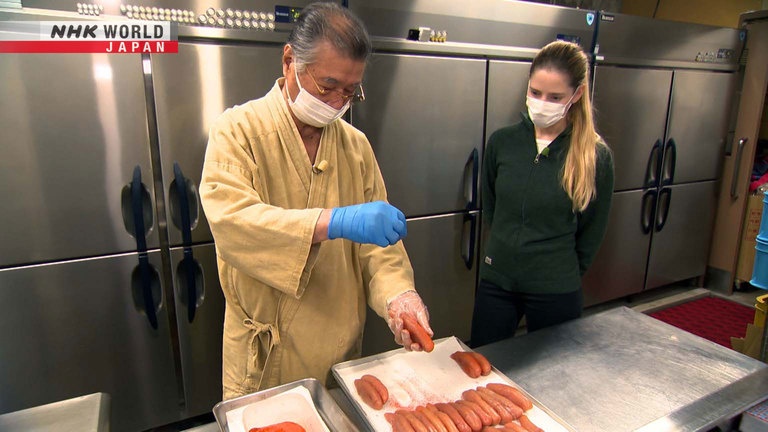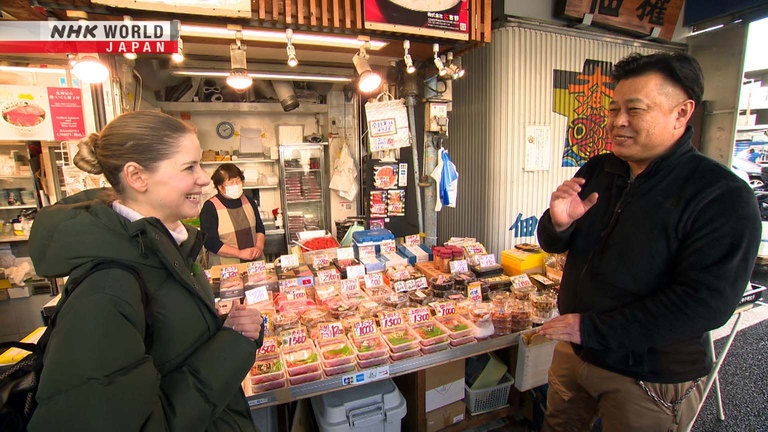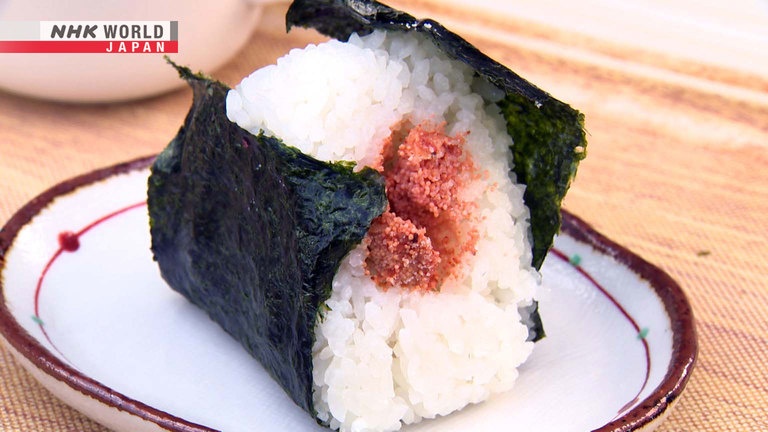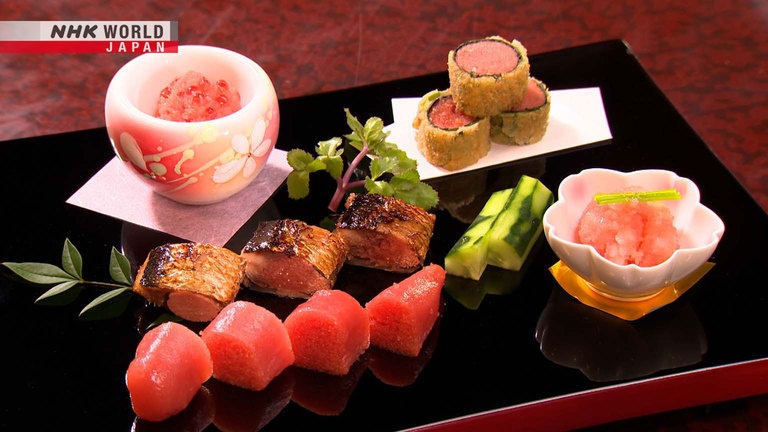MENTAIKO
Mentaiko is cured and spiced pollock roe, with a deep flavor provided by kombu and katsuobushi broth. Discover the secrets of a beloved food that spread from Fukuoka to the rest of Japan. (Reporter: Janni Olsson)




Transcript
Tokyo: this world-class metropolis is a veritable gourmet wonderland.
Discover the stories behind the ingredients that make this city so delicious - so "oishii."
People around the world enjoy fish roe like caviar, bottarga, and taramasalata.
Various types are eaten in Japan as well, the most popular being mentaiko.
It's great with rice and pasta... and even bread!
Mentaiko is a key part of the Japanese diet.
It mostly comes from Hakata, Fukuoka, in southern Japan.
The city's long history as a port town makes it a treasure trove of food.
"Oishii!"
From Fukuoka to the world.
Let's explore the charms of mentaiko.
Trails to Oishii Tokyo.
Hello, my name is Janni Olsson, and the theme of today's show is mentaiko.
Now, even though we have some similar products back in Sweden,
when I first came to Japan, I was quite confused about the difference about all these products in Japan
that uses fish egg like tarako and mentaiko and caviar.
So, today I want to shed some light on that. So, let's go.
The Tsukiji Outer Market is home to 460 specialty shops and restaurants.
Crowded from early morning, it's a popular stop for tourists.
Wow, look at these lines.
Janni heads to a specialty fish roe shop -
something you don't find just anywhere in Japan.
How many fish roe products
does Japan have?
Tarako, mentaiko, sujiko,
ikura, kazunoko, komochi kombu...
Those are just the main ones.
What fish roe is mentaiko made from?
Alaska pollock roe.
If it's spiced, it's mentaiko.
Only salt-cured, it's tarako.
- Both are made using the same fish roe.
- That's right.
Interesting.
Mentaiko isn't a type of fish.
Tarako is salt-cured Alaska pollock roe sacs - the ovaries.
It's processed with chili peppers and other seasonings to make mentaiko.
As for the other types he mentioned: sujiko and ikura are made from salmon or trout roe.
Kazunoko and komochi kombu are made from herring roe.
Where are the fish caught?
In the past, mostly around Japan.
Now, mainly the US and Russia.
Japan is known for its seafood catches,
so that's quite surprising.
Fish previously caught in the south
are now caught up north around Hokkaido.
Fishing has shifted north
because of warming waters.
Pollock live near the ocean floor,
but they're moving into deeper, colder waters.
That's making it tough for fishers.
Alaska pollock fishing occurs from October to March.
Modern freezing and shipping technology allow for a year-round supply.
Where could I learn
more about mentaiko?
Hakata in Fukuoka, on the
southern island of Kyushu.
Many mentaiko companies are there.
- Good food too?
- Sure.
- Yeah?
- Great sake too.
Can't miss that!
They even offer a selection of dishes made with fish roe.
In Japan, mentaiko with rice or pasta are popular choices.
"Itadakimasu."
"Oishii."
Okay, so in Sweden, actually, we eat these kind of things like caviar with bread or egg,
so it's real refreshing to eat this with rice. But it goes so well together.
The rice kind of takes away the edge of the spiciness.
Mentaiko pasta.
I think it's like chili or something in the mentaiko, so it's really, really spicy.
But in the pasta here, they have this kind of creamy feeling in it.
So it kind of wraps around the spiciness.
And it goes so well together with pasta.
It's a good one.
Spicy!
So, we have just arrived in Fukuoka. Let's go!
Fukuoka is a 2-hour flight from Tokyo.
70% of Japan's mentaiko production happens here.
After the shinkansen connecting Tokyo and Hakata opened in 1975,
travelers to Fukuoka for business and pleasure increased.
Mentaiko became a popular item to bring back as a souvenir, leading to the food's national fame.
They say around 200 mentaiko producers are located in Fukuoka alone.
In fact, local department stores have large sections dedicated to mentaiko products.
To see some of those products, Janni heads to a specialty shop.
Look at all this mentaiko.
So it seems like they have a lot of different mentaiko here
and it kind of differs depending on who the maker is here, so...
Wow, look at these.
Okay, so it seems like they don't only have the mentaiko like it is;
they actually have it in a lot of versions of snacks here.
Is this mentaiko too?
Mentaiko mayonnaise.
That's right. Japanese love mentaiko so much,
they make all kinds of processed foods and snacks out of it.
If you like mentaiko, the fun is never-ending.
The shop even lets customers make their own mentaiko.
Janni, of course, will give it a shot.
But first...
She samples some to see how spicy she likes it.
The spice hits later.
It does.
Is it too spicy?
Being from Sweden,
this is quite spicy.
This is our medium-spicy product.
I'll use these.
How do they feel?
Very firm.
They won't fall apart.
Two types of chili peppers are used.
The powdered type is for adjusting overall pungency, because it absorbs into the food better.
The coarser type is for added flavor and aroma.
I'll give it a shot!
I'm not used to spicy food.
How much pepper should I use?
A spoonful is good.
That'll be less spicy
than the one you ate.
Janni begins work on her... somewhat spicy mentaiko.
I want to add a kick of yuzu citrus.
Add yuzu peel or kombu for extra flavor.
You may wonder why kombu is here.
Kombu is often used to make broth.
Adding kombu to this provides sweetness.
It's also good to add alcohol.
They can't be mixed.
Just chose one, and add it as seasoning.
Fish roe is raw, so alcohol kills bacteria.
It also masks the fishy smell,
and it enhances overall flavor.
Actually, most producers use sake specifically.
What will Janni go for?
I'll try brandy.
I think it'll go well with yuzu citrus.
Brandy mentaiko is rare!
I'm intrigued!
All this is blended to make a special marinade.
Most producers use either katsuobushi or kombu broth.
I can't tell you exactly how ours is made.
Companies produce their own marinades
to make the tastiest mentaiko possible.
It's a key part of the process.
After the special liquid is poured in, the mentaiko marinates in the refrigerator for five days.
Janni tries two kinds: one using white wine, and one using brandy.
This one used white wine.
- It has a lovely pink color.
- Yes.
The white wine comes as an aftertaste.
At first, it's fruity and pungent.
It's just mentaiko at first,
then a wine aroma kicks in.
Next up, brandy mentaiko.
- "Itadakimasu."
- Enjoy.
- How is it?
- It's sweet!
Sweet and spicy!
- It has the smokey sweetness of brandy.
- Right.
I thought using sake was good enough,
but this offers a fun twist.
You can marinate it however you like.
- It makes quite a difference.
- It does.
But this is only the tip of the mentaiko iceberg.
This restaurant is known for using homemade mentaiko in its traditional recipes.
For the marinade, they use a mixture of kombu, katsuobushi, sake, mirin sweet sake, and other ingredients.
For spice, they use rare Japanese chili peppers.
This appetizer offers an assortment of mentaiko foods.
Here, mentaiko is rolled in nori seaweed and kombu flakes.
That's wrapped in shiso leaves dipped in batter.
Then, breadcrumbs are sprinkled on, and the whole thing is deep-fried.
"Itadakimasu."
"Oishii."
It's fried and crispy on the outside,
but the mentaiko is soft inside.
Shiso is an acquired taste.
It has a unique flavor.
But it's perfect with mentaiko.
Combining shiso with marinated mentaiko
is what makes this dish so tasty.
- And mentaiko remains the star.
- True.
Next up, a mentaiko sardine.
Bones and cartilage are pulled away before the fish is sliced open.
The fish is wrapped around mentaiko.
That's soaked for 24 hours in the same broth the mentaiko was soaked in.
Finally, it's brushed with soy sauce and mirin sweet sake, and grilled.
I'll try this one.
"Itadakimasu."
- How is it?
- "Oishii."
Easy to eat, and soft.
It almost melts in your mouth.
- Lovely savory, grilled aroma.
- Right.
I thought it'd be spicier.
Mentaiko is said to originate in South Korea.
Fukuoka is nearby, which makes sense.
Using Japanese-style broth made it
more popular, and it became a local specialty.
So broth is quite important.
It works with the spices
to enhance overall flavor.
It's more than just spicy.
- Elegant and spicy.
- Thank you.
Try adding spicy mentaiko to sweet Japanese omelets!
Now for a hot pot.
Mentaiko is mixed into the broth.
- "Oishii." Excellent.
- Thank you.
The mentaiko keeps its texture
even after boiling.
The grains remain intact.
The flavor is present too.
A warm and cozy dish.
Mentaiko is great for that.
Yes. I wasn't expecting to eat
mentaiko in a hot pot.
Whether cooked or raw, mentaiko plays nicely with other ingredients, boosting overall flavor and texture.
In Japanese cuisine, the ingredient wears many hats.
Janni heads to a shop that strives to make the best mentaiko possible
by researching and experimenting with various ingredients.
- Hello.
- Nice to meet you.
What makes your mentaiko stand out?
My goal was to make mentaiko that's
healthy, easy to eat, and tasty.
Yasuda Mikio used to own a computer software company.
Before turning 60, he left the company to train at a Japanese restaurant and learn all about mentaiko.
He spent three years developing unique recipes.
You have many types.
What are the main differences?
Roe varies in quality.
Better ingredients make tastier mentaiko.
We sell the most expensive mentaiko.
I see that!
- You carefully select ingredients from the start.
- Exactly.
Wonderful.
Yasuda seeks quality products mainly from the US.
US fish are caught deep in the ocean.
The water pressure makes their meat better.
Fish prices also depend on how
they're processed post-catch.
US and Russian facilities operate differently,
which is reflected in market prices.
Market prices are influenced by the technology and equipment used on fishing boats.
His roe is removed on board and flash-frozen.
Aside from roe, he also makes sure to select the finest broth ingredients.
This kombu kelp is from Rishiri Island in Hokkaido, which is known for quality kombu.
It makes a rich broth often used in traditional course meals.
The katsuobushi also comes from famous production areas.
He incorporates flakes from veiny parts of the fish for a richer flavor.
I use Kyoto-style broth, which is
the root of Japanese cuisine.
That base creates the most natural flavor.
He takes out kombu that soaked overnight, and to the broth...
he adds a colander full of katsuobushi.
They're strained after a short boiling time so they don't release bitterness.
This base broth is called "ichiban dashi," meaning first broth.
How does it taste?
- Smooth, right?
- Nice and mild flavor.
I was surprised you took
the flakes out so quickly.
Soy sauce, sake, and mirin sweet sake are added to the ichiban dashi.
He uses two types of rare domestic peppers.
They're quite pungent, but have a rich aroma.
This completes a special marinade of natural ingredients.
Now it's time to soak the roe.
Nice.
- Pretty, right?
- Lovely pink color.
No additives. Natural color.
The roe marinates for seven days in a refrigerator, slowly aging in a low temperature.
I see now that broth is very important.
Do you always make it
with the same recipe?
The broth and marinade recipe
change with the seasons.
Temperature and humidity differences
influence the ingredients we use.
Some roe are more absorbent than others.
We have to be aware of various factors.
Even now at age 82, he carefully selects ingredients and fine-tunes his recipes.
It's finally time to try his mentaiko!
- "Itadakimasu."
- Enjoy.
"Oishii."
I can feel the grains.
It's juicy too.
Yes, and it has a refreshing aftertaste.
The spiciness of some mentaiko
can be strong and long-lasting.
But this is just right.
It's important to use
natural ingredients.
Amazing.
He's dedicated his life to making tasty, one-of-a-kind mentaiko.
At night, the downtown streets of Hakata are lined with food stalls that attract hungry crowds.
The atmosphere represents a big part of Fukuoka's food culture.
Janni will finish off with some bar food -
well, food that people like to eat while drinking.
This vendor is known for a variety of mentaiko options.
Can we talk?
Sure. I'm not very interesting though.
Do you come to this area often?
No, I'm a tourist.
I just arrived today.
Did you come to eat street food?
Yeah, I really wanted to try some.
It's my first time here.
I'm excited.
It's surprising to see
so many mentaiko dishes.
- Really?
- It's a big menu.
A grilled pork and lettuce roll, with fresh mentaiko.
The mentaiko cooks through halfway.
"Itadakimasu."
So good!
Tasty, but with a great texture too.
Charcoal grilling helps
the lettuce stay crispy.
- That was fast!
- Mentaiko with avocado and cream cheese.
Wow!
How'd you come up with that?
I ate something similar
at a restaurant in France recently.
It's based on that.
So good.
Finally, piping-hot Japanese-style ajillo.
Enjoy.
It smells so good.
Place bits of mentaiko and fish on toasted bread.
This is great!
This spicy umami kick you get is, like, so good.
I've been trying a lot of different things,
but it's really surprising that it actually also goes really well together with bread.
So, it goes well with rice and it goes well we bread.
So, it's kind of like this all-mighty ingredient.
In Japan, mentaiko went from being a local hero to a national star.
Tasty either cooked or raw, it's up for any culinary challenge.
The key to great mentaiko is the broth, and the passion of the artist who creates it.
In Tokyo, and Fukuoka... every ingredient has its own story.